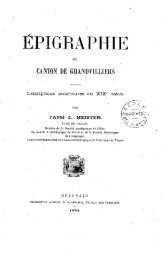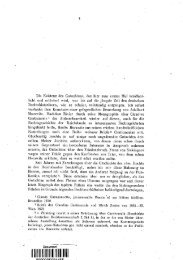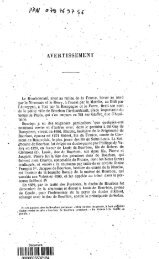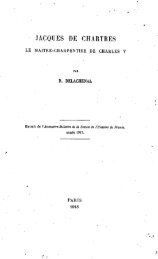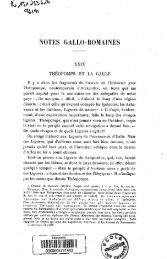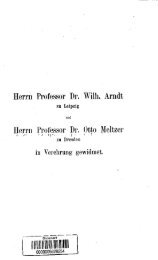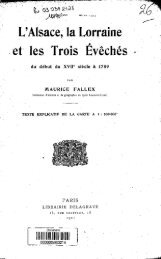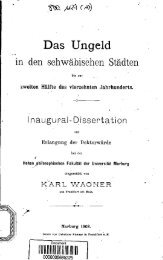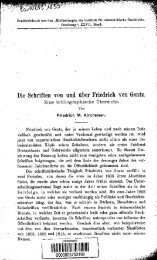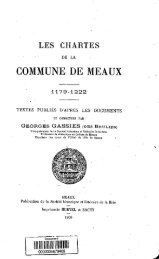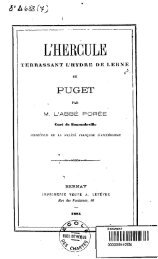4P Li gç(' TRANSACTIONS
4P Li gç(' TRANSACTIONS
4P Li gç(' TRANSACTIONS
Create successful ePaper yourself
Turn your PDF publications into a flip-book with our unique Google optimized e-Paper software.
786 LE LIVRE DE YCONOMIQUE D'ARISTOTE [TRANS. AMER. PHIL. SOC.<br />
example, admonishes his brother in Homeric verse to<br />
seek wealth and prosperity through diligent work—"Between<br />
us and success the gods have placed the sweat of<br />
our brows" 2 —through just dealings with one's neighbors,<br />
by apportioning the tasks of the household around<br />
the calendar of the seasons, by marrying before thirty<br />
and living righteously by propitiating the gods. Xenophon,<br />
disciple of Socrates and friend of Plato, enlivened<br />
his discussion of the household arts, as practised<br />
in fourth-century Greece, by his masterly use of the<br />
dialogue form. ,' The style of our Economics is severely<br />
analytical and expository, rarely adorned with illustrative<br />
examples. Although a warm human sympathy can<br />
be sensed in the section dealing with the husband-wife<br />
relationship, the text adheres closely to the scientific<br />
objective of the writer, whose model was certainly<br />
Aristotle, the master of the expository style.<br />
During the Dark Ages, the production of new works<br />
on household economy languished almost to the vanishing<br />
point. The instructions for planting of seeds in a<br />
monastery garden, the Hortulus written about 840 by<br />
the German monk \Valafrid Straho, is a shining exception<br />
to the rule. In the thirteenth and fourteenth centuries<br />
a revival of interest in rural economy on the great<br />
feudal estates gave rise to several treatises on the management<br />
of these large properties. The thirteenth-century<br />
Anglo-Norman treatise on husbandry by Walter of<br />
Henley is the earliest work of its kind in a modern language.<br />
The fortunes of Pietro Crescenzi's Duodecim<br />
libri ruralium conunodorum, written about 1300, were<br />
distinctly better; its reputation was sufficiently great to<br />
recommend it to Charles V of France for translation into<br />
French (1370). Under two titles, Le <strong>Li</strong>vre des prouffits<br />
champestres ci rurcudx and Le <strong>Li</strong>vre appellé Rustican<br />
du champ de labeur, it was widely disseminated in manuscript<br />
before it was printed in 1486. Its popularity continued<br />
for another half-century and a revised edition<br />
appeared in Paris in 1560. The first original French<br />
work on family economy was Le bon berger, written<br />
about 1375 by Jean de Brie; this work enjoyed popular<br />
favor for two centuries and was frequently reprinted.<br />
Very similar in every respect save style is La Somme<br />
rurale by Jean Boutillier (1380), which Vérard published<br />
in Paris in 1491. The principal theme of Le<br />
<strong>Li</strong>vre du chevalier de 1cm Tour-Landry pour l'enseignenient<br />
de ses flUes (1371) is the duty of the wife to her<br />
husband, and the husband-wife relationship is likewise<br />
the major concern of the anonymous author of Le<br />
Ménagier de Paris (1393). This revival of interest in<br />
economics among the French suffered a sharp decline in<br />
the fifteenth century; no important work appeared in<br />
French until 1564, when Charles Estienne published his<br />
2 Hesiod, Works and days, ed. with parallel English translation<br />
by H. G. Evelyn-White, line 289, Loeb Classical <strong>Li</strong>brary,<br />
Harvard Univ. Press, 1936.<br />
Xenophon, Memorabilia and Oeconomicus, ed. with parallel<br />
English translation by E. C. Marchant, Loeb Classical <strong>Li</strong>brary,<br />
London, Heineniann, 1923.<br />
Maison rustique; originally composed in Latin, the<br />
French edition was often reprinted until 1702. In the<br />
meantime, the Italian Humanists had produced several<br />
original treatises on the subject, the best known being<br />
Alberti's Della. Famiglia (1445), which circulated in<br />
French and German translations throughout the sixteenth<br />
century. Of all the works we have named above,<br />
only Alberti's shows definite indebtedness to the Economnics<br />
attributed to Aristotle .4<br />
III. THE GREEK AND LATIN OECONOMICzI<br />
The history of this pseudo-Aristotelian treatise is<br />
both curious and involved. The Greek original of the<br />
first two Books is found in the manuscript copies of<br />
the Aristotelian corpus immediately following the Politics,<br />
but no Greek text of the third Book has been current<br />
since the fourteenth century. As early as the<br />
sixteenth century, the 1-lumanist editors of Aristotle were<br />
questioning the authenticity of the treatise. In 1506<br />
the French humanist I.efèvre d'Etaples proved conclusively<br />
that the second Book is entirely spurious,' since<br />
it contains references to persons known to have been<br />
born after Aristotle's death in 322 nc. There is general<br />
agreement that the first Book is, both in style and content,<br />
worth y of the Stagyrite; it contains numerous passages<br />
paraphrased from his Politics, while several sections<br />
have beemi traced hack to Xenophon's Oeconomicus.<br />
6 Xenophon was pillaged further by the unknown<br />
author of Book III, which is a highly interesting disquisition<br />
on the relations of husband and wife in the family<br />
economy. It has been conjectured that this third Book<br />
may be the Latin version of a late Greek tract, now lost,<br />
entitled Rules for married life, included in a list of works<br />
attributed to Aristotle drawn up in the sixth century<br />
by the lexicographer Hesychius of Miletus. Thus the<br />
Greek original of the Economics was it compilation of<br />
disparate materials assembled by unknown hands at<br />
various times after Aristotle's death and mistakenly<br />
introduced into the Aristotelian corpus at an unknown<br />
date, but quite certainly before the twelfth century, when<br />
the great Arabic commentator on Aristotle, Averrhoes,<br />
wrote a paraphrase of the treatise which was current in<br />
a Latin translation about 1260.<br />
If the history of the Greek text is intricate and confusing,<br />
that of the mediaeval Latin versions of the<br />
This brief account of a largely neglected segment of didactic<br />
literature is, of course, far from complete. It is a subject that<br />
begs for serious and full examination.<br />
Faber Stapulensis (Le Fèvre d'Etaples), Qeconomica Arisfotelis,<br />
126 If., Paris, H. Estiennc, 1506. The best critical edition<br />
of Book II is that by B. A. Van Groningen, Le deuxiè.'ne Uvre<br />
de l'1cononiiquc, 233 pp., Leyden, 1933. On the authenticity of<br />
Book II, cf. Otto Schlegel, J?eiträge .ur Untersuchungen iiber<br />
die Glaubwdrdigkeit der Beispielsammiung in den pseudoaristotelischen<br />
Oekonomika, Weimar, 1909 (dissertation).<br />
6 Written about 370 ac. Franz Susemihi, ed. Aristo tells quac<br />
feruntur Oecono;nica, v-vi, note 1, Leipzig, Teuhner, 1887, lists<br />
the parallels with Aristotle's Politics and Xenophon's Occono<br />
HI CUS.




